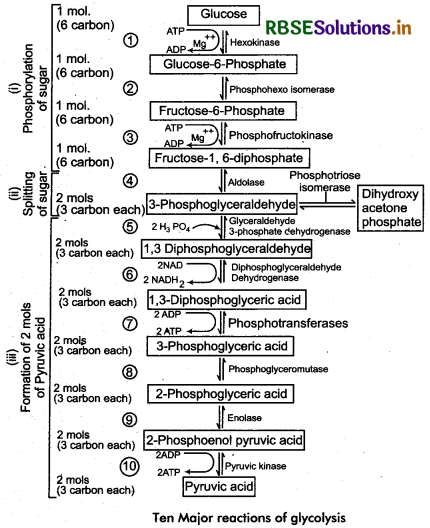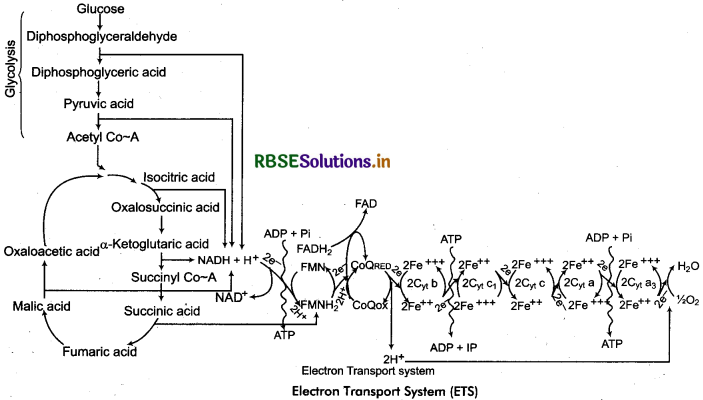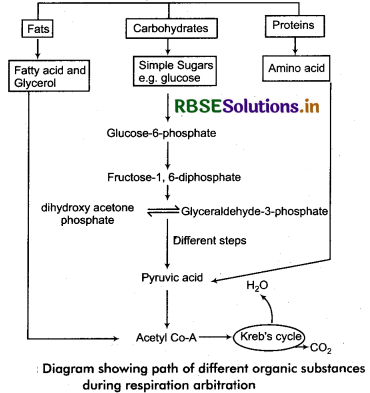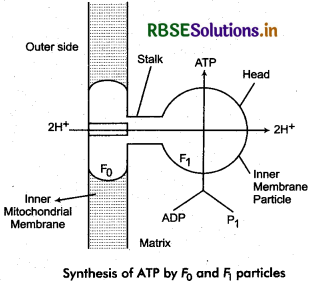RBSE Solutions for Class 11 Biology Chapter 14 Respiration in Plants
Rajasthan Board RBSE Solutions for Class 11 Biology Chapter 14 Respiration in Plants Textbook Exercise Questions and Answers.
Rajasthan Board RBSE Solutions for Class 11 Biology in Hindi Medium & English Medium are part of RBSE Solutions for Class 11. Students can also read RBSE Class 11 Biology Important Questions for exam preparation. Students can also go through RBSE Class 11 Biology Notes to understand and remember the concepts easily.
RBSE Class 11 Biology Solutions Chapter 14 Respiration in Plants
RBSE Class 11 Biology Respiration in Plants Textbook Questions and Answers
Question 1.
Differentiate between:
(a) Respiration and Comhustion.
(b) Glycolysis and Kreb’s Cycle.
(c) Aerobic Respiration and Fermentation.
Answer:
(a) Difference between Respiration and Combustion
|
Respiration |
Combustion |
|
1. Respiration is a process that occurs in living cells i.e., it is a biological process. |
It is a process that occurs in non-living substances, i.e., it is a chemical process. |
|
2. Several enzymes take part in this process. |
Enzymes do not take part in this process. |
|
3. This process occurs slowly at normal temperature of environment. |
This process occurs rapidly in high temperature. |
|
4. Most of the energy released during this process is again stored in other chemical compound (ATP). |
Most of the energy released is lost in the form of heat. |
|
5. The energy is released slowly, hence there is a small rise in temperature. |
All the energy is released suddenly hence there is large increase in temperature. |

(b) Difference between Glycolysis and Kreb’s Cycle
|
Glycolysis |
Kreb’s Cycle |
|
1. It completes in linear step/pathway. |
It completes in cyclic step/pathway. |
|
2. It takes place m cytoplasm, in this respiratory substrate is glucose. |
It takes place in mitochondria, in this respiratory substrate is acetyl Co-A. |
|
3. It is the first step of respiration. |
It is the third step of respiration. |
|
4. Two molecules of pyruvic acid are formed by the breakdown of one molecule of glucose. |
In organic substances (CO2 and H2O) are formed by the complete breakdown of acetyl Co-A. |
|
5. It occurs both in aerobic and anaerobic respiration. |
It occurs in aerobic respiration only. |
|
6. It generates two molecules each of NADH2 and ATP by the breakdown of one molecule of glucose. |
It generates six molecules of NADH2, two molecules of FADH2 and two molecules of ATP from two molecules of acetyl Co-A. |
|
7. O2 is not required in glycolysis. |
O2 is used as terminal oxidant in Kreb’s cycle. |
|
8. CO2 is not evolved in this process. |
CO2 is evolved in this process. |
|
9. There is net gain of 2 molecules in it. |
There is net gain of 24 molecule in it. |
|
10. It is not related to oxidative phosphorylation. |
It is related with oxidative phosphorylation. |
(c) Difference between Aerobic respiration and Fermentation
|
Aerobic respiration |
Fermentation |
|
1. It is a process of respiration takes place in the presence of oxygen. |
It is the process which does not require oxygen. |
|
2. This process occurs in living cells. |
It occurs in the presence of substrate and enzyme, living cell is not required. It is usually done by yeast and bacteria. |
|
3. Many enzymes takes part in this process. |
A few enzymes takes part in this process. |
|
4. Large amount of energy is released due to complete oxidation of food substances. |
Less amount of energy is released due to incomplete oxidation of food substances. |
|
5. CO2 and H2O are formed by the oxidation of sugar. |
CO2 and alcohol or other organic acids are formed by oxidation of sugar. |
Question 2.
What .are respiratory substrates? Name the most common respiratory substrate.
Answer:
In respiration, complex organic substances are oxidized and energy is released. These substances are called respiratory substrates. According to Mohl and James (1942), substrates are those organic substances which after oxidizing release chemical energy for the growth and development of cells. Carbohydrates, fats, proteins and organic acids found in cell may be used as respiratory substrates.
If all the above substrates are available in the cell, first of all, only carbohydrates are utilized. Glucose (C6H12O6) is mostly utilized respiratory substrate.
Question 3.
Give the schematic representation of glycolysis.
Answer:

Question 4.
What are the main steps in aerobic respiration? Where does it takes place?
Answer:
Steps of Aerobic Respiration : The oxidation of organic food substances in cells, in the presence of oxygen (O2) is called aerobic respiration. In this process, chemical energy is stored in ATP as bond energy.
C6H12O6 + 6O2 → 6CO2 ↑ + 6H2O + energy
The main steps of aerobic respiration are as follows :
(a) Glycolysis : It occurs in cytoplasm. In this process, two molecules of pyruvic acid are formed from one molecule of glucose by a series of reactions. It generates two molecules each of NADH2 and ATP.
(b) Formation of Acetyl-co-enzyme-A : The pyruvic acid produced during glycolysis enters the matrix of mitochondria where its oxidative decarboxylation occurs in the presence of NAD and sulphur containing compound Co-enzyme A. During this step, one molecule of CO2 is evolved from pyruvic acid and NADH2 is formed and in the end, acetyl co-enzyme A is formed.

(c) Kreb's Cycle or Tricarboxylic Acid Cycle : All the reactions of this cycle occurs in the presence of oxygen in mitochondria and CO2 and water are formed by the breakdown of pyruvic acid, fatty acid and amino acid. The acetyl Co-A formed in the process of oxidative decarboxylation enters the Kreb’s cycle to get oxidized. The complete oxidation of acetyl Co-A, includes the reaction of Kreb’s cycle and electron transport system.
Acetyl Co-A + 2H2O + 3NAD + FAD + GDP + ip → 2Co-A + 2CO2 + 3NADH2 + FADH2 + GTP
(d) Electron Transport System : It occurs on oxysomes or F1 particles present on inner membrane of mitochondria. In the process of oxidation of Kreb’s cycle, the enzyme dehydrogenase releases the pairs of hydrogen and electrons. Hydrogen and electrons combine with oxygen to form water passing through some mediatory transporters. At the time of transfer of hydrogen and electrons from one electron acceptor to other, energy is released. This energy is stored as ATP.

Question 5.
Give the schematic representation of an overall view of Kreb’s cycle.
Answer:
It has been discussed earlier, that aerobic respiration is the process in which oxygen is required. Although above glycolysis process is common to both aerobic and anaerobic respiration but when the breakdown of pyruvic acid takes place in the presence of oxygen, then it is called aerobic respiration. If the break-down of pyruvic acid occurs in absence of oxygen, then it is called anaerobic respiration.
In the presence of oxygen, pyruvic acid is decomposed into carbon dioxide and water and the energy produced during this process is stored in the form of ATP. The pyruvic acid formed in the cytoplasm enters the mitochondria because all the enzymes related to aerobic respiration are found in mitochondria only, i.e., this process takes place in the cell, hence, it is known as cellular respiration.
The pyruvic acid produced by glycolysis in cytoplasm now enters the matrix of mitochondria where its oxidative decarboxylation takes place in the presence of NAD and sulphur containing compound co-enzyme A. During this process, one molecule of CO2 is released from pyruvic acid and NADH2 is also formed, and in the end acetyl co-enzyme-A is formed. In fact, the formation of acetyl co-enzyme-A from pyruvic acid by oxidative decarboxylation is complex process in which three enzymes such as pyruvic acid decarboxylase; dihydrolipyl transacetylase and dihydrolipyl dehydrogenase and six co-factors such as Mg++, thiamine pyrophosphate (TPP), NAD, Co-A, FAD and lipolic acid are involved. The summary for this step is

Acetyl Co-A serves as connecting link between glycolysis and Kreb’s cycle.
Question 6.
Explain ETS.
Answer:
Electron transport system is also called oxidative phosphorylation. The dissociation of glucose molecule in the presence of oxygen is the process of oxidation. Glucose molecule is completely oxidized by the end of Kreb’s cycle. However, energy is not released until NADH2 and FADH2 are oxidized. The synthesis of ATP with the help of energy released by the oxidation of NADH2 and FADH2 is called oxidative phosphorylation. But NADH2 or FADH2 does not combine directly with oxygen, the electrons reach to oxygen from them through a series of electron carriers. This series of electron carriers is known as electron transport chain or electron transport system.
The formation of electron transport chain occurs by many co-enzymes such as : NAD, FMN, FAD, co-enzyme Q, cyt-b, cyt-c, cyt-1, cyt-c, cyt-a and cyt-a3. All these co-enzymes are found in Ft particle situated on the inner membrane of mitochondria.

Question 7.
Distinguish between the following :
(a) Aerobic respiration and Anaerobic respiration.
(b) Glycolysis and Fermentation.
(c) Glycolysis and Citric acid cycle.
Answer:
(a) Aerobic respiration and Anaerobic respiration :
|
Aerobic Respiration |
Anaerobic Respiration |
|
1. It occurs in the presence of oxygen. |
It occurs in the absence of oxygen. |
|
2. It is generally found in all higher plants. |
It generally occurs in mostly bacteria and fungi. |
|
3. It is a stable process, occurs life long in plants. |
In higher plants it occurs in anaerobic conditions temporary phase. |
|
4. Complete oxidation of organic substances takes place. |
Incomplete oxidation of organic substances takes place. |
|
5. Large amount of energy is produced. One molecule of glucose produces 38 ATP molecules. |
A less amount of energy is produced. One molecule of glucose produces 2 ATP molecules. |
|
6. It occurs in cytoplasm and mitochondria. |
It occurs in cytoplasm only. |
(b) Difference between Glycolysis and Fermentation
|
Glycolysis |
Fermentation |
|
1. This process takes place in the absence of oxygen (O2). |
This process takes place in the presence or absence of oxygen. |
|
2. It is common for both aerobic and anaerobic respiration. |
It is a complete process. |
|
3. It occurs in cytoplasm of all living organisms. |
It occurs in external medium of some organisms. |
|
4. Many enzymes takes part in this process. |
A few enzymes takes part. |
|
5. The end product is pyruvic acid. |
The end products are alcohol, CO2 or other organic substances. |
|
6. 8 ATP molecules are formed. |
2 ATP molecules are formed. |
(c) Difference between. Glycolysis and Citric Acid Cycle :
|
Glycolysis |
Kreb’s Cycle |
|
1. It completes in linear step/pathway. |
It completes in cyclic step/pathway. |
|
2. It takes place m cytoplasm, in this respiratory substrate is glucose. |
It takes place in mitochondria, in this respiratory substrate is acetyl Co-A. |
|
3. It is the first step of respiration. |
It is the third step of respiration. |
|
4. Two molecules of pyruvic acid are formed by the breakdown of one molecule of glucose. |
In organic substances (CO2 and H2O) are formed by the complete breakdown of acetyl Co-A. |
|
5. It occurs both in aerobic and anaerobic respiration. |
It occurs in aerobic respiration only. |
|
6. It generates two molecules each of NADH2 and ATP by the breakdown of one molecule of glucose. |
It generates six molecules of NADH2, two molecules of FADH2 and two molecules of ATP from two molecules of acetyl Co-A. |
|
7. O2 is not required in glycolysis. |
O2 is used as terminal oxidant in Kreb’s cycle. |
|
8. CO2 is not evolved in this process. |
CO2 is evolved in this process. |
|
9. There is net gain of 2 molecules in it. |
There is net gain of 24 molecule in it. |
|
10. It is not related to oxidative phosphorylation. |
It is related with oxidative phosphorylation. |

Question 8.
What are the assumptions made during the calculation of net gain of ATP?
Answer:
It is possible to make calculations to the net gain of ATP for every glucose molecule oxidised but in really this can remain only a theoritical exercise. These calculations can be made only on certain assumptions that:
- There is a sequential orderly pathway functioning, with one substrate forming the next and with glycolysis. TCA cycle and ETS pathway following one after another.
- The NADH synthesized in glycolysis is transferred into the mitochondria and undergoes oxidative phosphorylation. None of the intermediates in the pathway are utilized to synthesize any other compound.
- Only glucose is being respired, no other alternative substrates are entering in the pathway at any of the intermediate stages.
But these kind of assumptions are not really valid in a living system, all pathway works simultaneously and do not take place one after another; substrates enter the pathways and are withdrawn from it as and when necessary; ATP utilized as and when reduced; enzymatic rates are controlled by multiple means. Hence, there can be a net gain of 38 molecules of ATP during aerobic respiration of one molecule of glucose.
Question 9.
Discuss “The respiratory pathway is an amphibolic pathway.”
Answer:
Glucose is a common substrate for respiration process, which is called cellular fuel. Other carbohydrates are also converted into glucose before respiration. The fats first are degraded into glycerol and fatty acids. Fatty acid enters into respiratory pathway converting to acetyl Co-A. Glycerol enters into respiratory pathway converting to phosphoglyceraldehyde (PGAL). Proteins degrade to form amino acid. Amino acids enter into different steps of Kreb’s cycle after deamination. Like wise in synthesis of fatty acid, acetyl Co-A isolated from respiratory pathway. Thus, during synthesis and degradation of fat the respiratory path used. Like wise during synthesis of and degradation of protein also use respiratory path. Such a way in respiratory path, there anabolism and catabolism go on together. This is the reason, the respiratory pathway is called amphibolic pathway.

Question 10.
Define R.Q. What is its value for fats?
Answer:
Respiratory Quotient (R.Q.) : The ratio of the volume of carbon dioxide (CO2) evolved to the volume of oxygen (O2) absorbed in respiration is called respiratory quotient (RQ).

RQ for Fats : When fats or oils are used as respiratory substrates, the value of R.Q. is always less than one because their molecules have less quantity of O2 in comparison to carbohydrates. Therefore, their oxidation requires more O2 and in turn CO2 liberation is less and R.Q. becomes less than unity as shown by the following equation.

Question 11.
What is oxidative phosphorylation?
Answer:
Oxidative phosphorylation is the synthesis of energy rich molecule of ATP with the help of energy liberated during oxidation of reduced co-enzyme (NADH, FADH2) produced in respiration.

Hydrogen acceptors NAD and FAD reduced by accepting hydrogen (H+) ions produced in different steps of aerobic respiration to form NAD • 2H or FAD, 2H, NAD, 2H gives at least 3 molecules of ATP and FAD • 2H gives at least 2 molecules of ATP by releasing electron to oxygen. During electron transfer, released energy is stored in ATP by the reaction ADP + ip → ATP as a result of electron transport. There 7.3 kcalin animal and 10-12 kcal energy in plants stored in formation of ATP. This processes called phosphorylation.
Because this process is occured in the presence of oxygen. Therefore it is called oxidative phosphorylation.

Question 12.
What is the significance of stepwise release of energy in respiration?
Answer:
The utility of step-wise release of energy in respiration are given as follows :
- There is a stepwise release of chemical bond energy which is very easily trapped in forming ATP molecules.
- Cellular temperature is not allowed to rise.
- There are several intermediates which can be used in production of a number of biochemicals.
- Wastage of energy is reduced.
- Through their metabolic, intermediates different substances can undergo respiratory catabolism.
- Each step of respiration is controlled by its own enzymes. The activity of different enzymes can be enhanced or inhibited by specific compounds.
This helps in controlling the rate of respiration and the amount of energy liberated by it.

- RBSE Solutions for Class 11 Biology Chapter 10 Cell Cycle and Cell Division
- RBSE Solutions for Class 11 Biology Chapter 9 Biomolecules
- RBSE Solutions for Class 11 Biology Chapter 8 Cell: The Unit of Life
- RBSE Solutions for Class 11 Biology Chapter 7 Structural Organisation in Animals
- RBSE Solutions for Class 11 Biology Chapter 6 Anatomy of Flowering Plants
- RBSE Solutions for Class 11 Biology Chapter 5 Morphology of Flowering Plants
- RBSE Solutions for Class 11 Biology Chapter 4 Animal Kingdom
- RBSE Solutions for Class 11 Biology Chapter 3 Plant Kingdom
- RBSE Solutions for Class 11 Biology Chapter 2 Biological Classification
- RBSE Solutions for Class 11 Biology Chapter 1 The Living World
- RBSE Solutions for Class 11 Biology Chapter 5 पुष्पी पादपों की आकारिकी